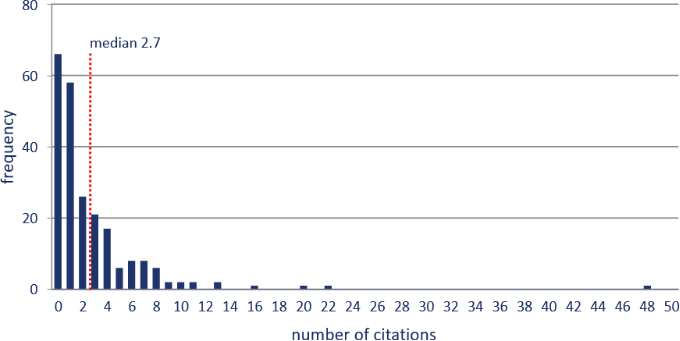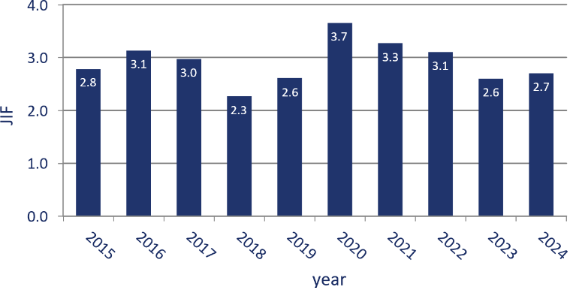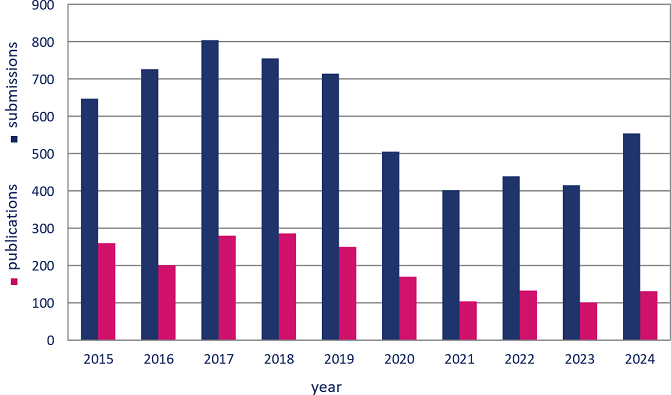Journal Statistics
It is well known that nanotechnology is an exceedingly multidisciplinary field, attracting researchers from physics to chemistry, computer science to biology, and many disciplines in between [1,2]. Given the diversity of topics covered in the Beilstein Journal of Nanotechnology, one set of statistics or bibliometrics will not suffice for the evaluation of such a journal, as it is well known that specific disciplines have vastly different citation patterns [3-5].
Bibliometrics can be used as indicators of general interest and trends, but of course they do not replace your own critical evaluation of an article. In order to help improve how the quality of research is evaluated, we became signatories to the San Francisco Declaration on Research Assessment (DORA) [6].
Various bibliometrics for the Beilstein Journal of Nanotechnology are presented below without emphasis on any particular metric. Definitions of some of the most widely used journal bibliometrics can be found in Wikipedia [7]. Please use the combination of these statistics together with your evaluation of our most recent articles to decide if the Beilstein Journal of Nanotechnology is an appropriate journal to publish your research. Thank you for considering our non-profit diamond open access journal for your nanotechnology publication.
Frequency Distribution of Citations
The following analysis is based on the method for calculating the frequency distribution of citations for a given journal, as described in detail in Reference [8]. The corresponding data were collected using the version of Web of Science available with our license, and the analysis was followed exactly as described in the referenced article.
Figure 1: Frequency distribution of citations in 2024 for articles published in 2022 and 2023.
h5-Index from Google Scholar Metrics
The h-index of a journal is the number of articles, h, in that journal that were cited at least h times each. And the h5-index of a journal is the h-index for articles published in the past five calendar years. The h5-index values for the Beilstein Journal of Nanotechnology for the past five years are shown below, and details on the most recent h5-index information can be found on the Google Scholar Metrics website [9].
Table 1: 2020–2024 h5-index based on Google Scholar Metrics.
| year | h5-index |
| 2020 | 35 |
| 2021 | 39 |
| 2022 | 40 |
| 2023 | 38 |
| 2024 | 35 |
Journal Impact Factor and Quartile Rankings (Clarivate)
Although it is the most commonly used metric to measure the impact of a journal on a discipline, and therefore of importance for authors, the Journal Impact Factor (JIF) alone is not sufficient to judge the quality of a journal. Moreover, it provides some information about the citation rate and distribution of a journal, but it has no direct significance for an individual article in the given journal. Please note that this bibliometric information is from Clarivate (a commercial entity), and the use of the JIF has been highly debated both in the publishing industry and research community [10-12].
The JIF for a given year is the ratio of the number of citations in that year to articles published in the past two calendar years, divided by the total number of publications published in the past two calendar years. For example, JIF 2024 = (no. of citations in 2024 to articles published in 2022 and 2023) ∕ (no. of articles published in 2022 and 2023).
The bar graph below shows the progression of the JIF for the Beilstein Journal of Nanotechnology for the past ten years. Based on the 2025 edition of the Journal Citation Reports® by Clarivate, the 2024 JIF is 2.7 [13].
Figure 2: 2015–2024 JIF as provided by Clarivate.
Additional information obtained from the Web of Science and The Lens databases:
5-Year JIF (2024): 2.8 [13]
Total citations (as of July 14, 2025): 58,651 [14]
Total citations 2024: 5997 [14]
SCImago Journal & Country Rank (Scopus® Metrics)
Without a subscription, the data contained in the proprietary Elsevier B.V. database Scopus® cannot be accessed. Alternatively, the SCImago Journal & Country Rank is a publicly available portal that includes information on the journals that are included in the Scopus® database [15]. This information for the Beilstein Journal of Nanotechnology is freely available on the SCImago Journal & Country Rank website [16].
2024 h-index as calculated by Scopus®: 88
The SCImago Journal Rank (SJR) indicator normalizes the citations based on the subject field. It is also based on Scopus® data and attempts to normalize for "journal prestige". The SJR data presented below is the weighted average number of citations in the given year for articles published over the past three calendar years (in contrast to the past two years as for the JIF).
Table 2: 2015–2024 SJR based on Scopus® metrics.
| year | SJR |
| 2015 | 1.001 |
| 2016 | 1.138 |
| 2017 | 1.119 |
| 2018 | 0.769 |
| 2019 | 0.663 |
| 2020 | 0.721 |
| 2021 | 0.664 |
| 2022 | 0.570 |
| 2023 | 0.520 |
| 2024 | 0.435 |
Other Statistics
The following graph gives the total number of submissions to and publications in the Beilstein Journal of Nanotechnology for the past ten years.
Figure 3: Total number of submissions to (blue) and publications in (red) the Beilstein Journal of Nanotechnology in 2015–2024.
The following statistics are for the reporting period Jan 1–Dec 31, 2024.
Acceptance rate: 23.90%
Desk rejection rate: 65.80%
Median number of reviews: 2.7
For other statistics related to our average publication times, please see our Editorial Policy and Workflow page.
References
- Porter, A. L.; Youtie, J. J. Nanopart. Res. 2009, 11, 1023–1041. doi:10.1007/s11051-009-9607-0
- Milojević, S. J. Nanopart. Res. 2012, 14, No. 685. doi:10.1007/s11051-011-0685-4
- Finardi, U. J. Informetr. 2014, 8, 13–24. doi:10.1016/j.joi.2013.10.003
- Sangwal, K. J. Informetr. 2014, 8, 972–984. doi:10.1016/j.joi.2014.09.009
- Lachance, C.; Larivière, V. J. Informetr. 2014, 8, 863–872. doi:10.1016/j.joi.2014.08.002
- DORA - American Society for Cell Biology. https://sfdora.org/ (accessed June 30, 2025).
- Journal ranking - Wikipedia. https://en.wikipedia.org/wiki/Journal_ranking (accessed June 30, 2025).
- Larivière, V.; Kiermer, V.; MacCallum, C. J.; McNutt, M.; Patterson, M.; Pulverer, B.; Swaminathan, S.; Taylor, S.; Curry, S. bioRxiv 062109. doi:10.1101/062109
- Beilstein Journal of Nanotechnology - Google Scholar Metrics 2025 h5-index. https://scholar.google.com/citations?hl=de&view_op=list_hcore&venue=9mn14ERKT5YJ.2025 (accessed July 31, 2025).
- Brembs, B.; Button, K.; Munafò, M. Front. Hum. Neurosci. 2013, 7, No. 291. doi:10.3389/fnhum.2013.00291
- Zhang, L.; Rousseau, R.; Sivertsen, G. PLoS One 2017, 12, No. e0174205. doi:10.1371/journal.pone.0174205
- Bornmann, L; Marx, W.; Gasparyan, A. Y.; Kitas, G. D. Rheumatol. Int. 2012, 32, 1861-1867. doi:10.1007/s00296-011-2276-1
- Journal Citation Reports Science Edition (Clarivate Analytics, 2025).
- The Lens. https://www.lens.org/ (accessed July 14, 2025).
- SCImago Journal & Country Rank. http://www.scimagojr.com (accessed June 30, 2025).
- Beilstein Journal of Nanotechnology - SCImago Journal & Country Rank. https://www.scimagojr.com/journalsearch.php?q=19700190315&tip=sid&clean=0 (accessed June 30, 2025).









